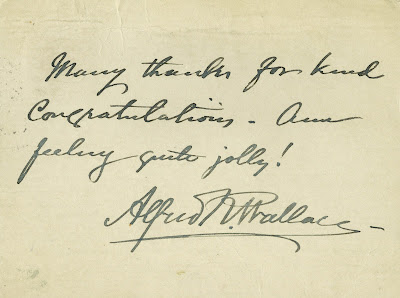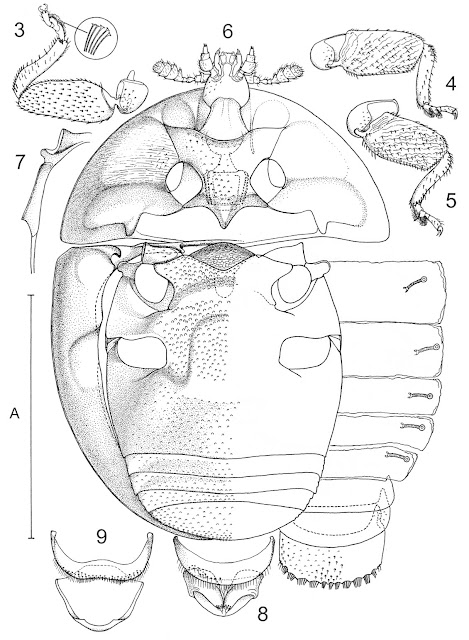In 2013, 100 years after his death, we celebrate the life of Alfred Russel Wallace (1823-1913), one of the greatest Victorian naturalists, travellers and collectors, a scientific and social thinker, early bio-geographer and ecologist, co-founder with Charles Darwin, of the theory of evolution through Natural Selection.
The Hope Entomological Collections (HEC) has many examples of species named after Wallace and of specimens collected by Wallace himself including species types such as Wallace's giant bee.
 |
| Megachile pluto described by B. Smith, 1869 is the largest bee species in the world. It occurs in Indonesia and builds its nest inside active termite nests. |
 |
| A letter from A.R. Wallace to E.B. Poulton, a former curator of the Hope Entomological Collections. |
Wallace was largely self-educated. He developed an interest
in natural history when young, and, like Darwin, became a keen beetle-collector.
Fourteen years younger than Darwin, and from a less wealthy background, Wallace
always had to earn a living while developing his scientific ideas. The Victorians were fascinated by the mystery behind the
development of species and the anonymous publication in 1844 of ‘Vestiges of
the Origin of Creation’ (actually written by Robert Chambers) caused a
sensation. Wallace determined to resolve the species question himself, and
travelled to South America with Henry Walter Bates to collect specimens and
theorise about species, inspired by earlier travellers such as Humboldt,
Edwards and Darwin himself.
Wallace spent four and a half years in Amazonia before
returning to England (losing most of his precious collections and notes in a
ship’s fire on the way home) and had already published some scientific articles
before publishing two short books, ‘A Narrative of Travels on the Amazon and
Rio Negro’ and ‘Palm Trees of the Amazon and their Uses’, but he realised he
needed to continue collecting if he was to achieve his aim.
Wallace chose as his new collecting ground, the Indonesian
region. Before leaving England, Wallace happened to meet Darwin briefly at the
British Museum. While Darwin continued his painstaking work on
barnacles and other researches, Wallace arrived in Singapore in 1854 and spent
eight and a half years travelling an estimated 14,000 miles throughout the
region, as described in his much republished book ‘The Malay Archipelago’.
It was here that Wallace wrote his illuminating essay ‘On
the Law which has Regulated the Introduction of New Species’ (known as the ‘Sarawak
Law’ paper) in 1855. This was followed in February 1858 by Wallace’s
most famous paper ‘On the Tendency of Varieties to Depart Indefinitely from the
Original Type’ which did lead Darwin to publish On The Origin of Species the
following year.
Wallace was suffering from malarial fever when the idea crystallised
in his mind. Between bouts of fever, he wrote out his theory in a few days, and
sent it to Darwin (whom he knew would be sympathetic to his ideas), hoping for
advice on whether and how to publish it. A key for both Darwin and Wallace in
formulating their theories of natural selection was recollection of Malthus’s
essay on population. Of course, when Darwin received Wallace’s letter, he was
presented with a dilemma. He had been working on his theory for twenty years,
and here was an outline of that theory, written by a relative unknown, far away
in the tropics. Darwin sought advice from Sir Charles Lyell and Joseph Hooker
(later Sir Joseph Hooker), who decided that it would be fairest to publish some
extracts of Darwin’s earlier writings together with Wallace’s paper, at the
next meeting of the Linnean Society. It happened that an emergency meeting was
being called and the papers were added to the agenda and read on 1 July 1858,
with neither author present (Wallace was still in the Malay Archipelago and
Darwin’s son Charles had just died).
Darwin was relieved when he found that far from resenting
his treatment, Wallace felt honoured for their ideas to be associated. In fact,
when writing about natural selection, Wallace chose the term ‘Darwinism’ and defended ‘Darwinism’ with vigour, both in England and abroad, describing himself as a ‘Darwinian’. Both
Darwin and Wallace recognised that their theory (which they both acknowledged
had been arrived at independently) had anticipators and were fully
aware of the importance of recognising the contributions of others. They remained
correspondents, consulting each other on various topics and Wallace was one of the pall-bearers at Darwin’s funeral.
Wallace was a believer in inspiration and said ‘all my best
ideas have come to me suddenly’. Modest to a fault, he was happy to receive
(among many other honours heaped on him) the Royal Society’s ‘Darwin’ medal, and described as ‘outrageous’ attempts to put him on same level as
Darwin.
When presented with the first ‘Darwin-Wallace’ medal by the
Linnean Society on 1 July 1908 (celebrating the anniversary of publication of
the Darwin-Wallace papers), Wallace contrasted himself with Darwin: “I was then (as often since) the
"young man in a hurry": he, the
painstaking and patient student, seeking ever the full demonstration of the
truth that he had discovered, rather than to achieve immediate personal
fame.”. Wallace felt himself more suited
to fieldwork (he was meticulous with his labels and had always recognised the
importance of noting the location where each specimen had been found) and was glad that Darwin had been able to provide the
vital detailed proofs and analysis for their controversial ideas.
Although they did not agree on everything (and sometimes had
to agree to disagree), Darwin and Wallace shared mutual respect and friendship,
and believed ardently in the spirit of co-operation, which their relationship
personified.
 |
| The postcard above, written in Wallace's handwriting reads as follows 'Many thanks for the kind congratulations- Am feeling quite jolly! Alfred R Wallace' |





